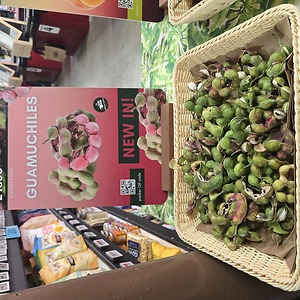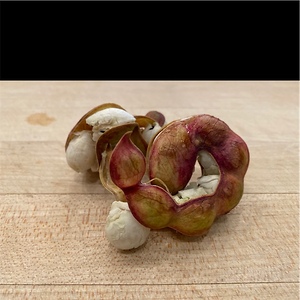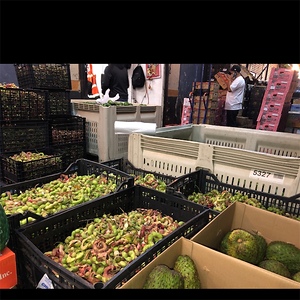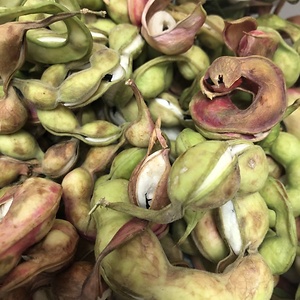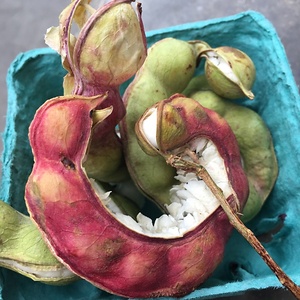


Madras Thorn
Estimated Inventory, lb : 0
Description/Taste
Madras Thorn is a small pod averaging 10 to 15 centimeters in length and 1 to 2 centimeters in diameter and has a straight to curved shape, twisting and coiling as it matures. The pods have a bubbled appearance, similar to tamarind, and appear in variegated shades of green, brown, red, and pink. The pod’s exterior is also textured, thin, and easily peeled, eventually bursting open to reveal pockets of fleshy seed arils. The edible pulp ranges in color from red, pink, to white and has a crisp, slightly grainy, and chewy consistency that melts on the tongue. Each pod can contain anywhere from 5 to 12 seed arils, and within the edible pulp, there is a flat, round, and black seed approximately 1 to 2 centimeters in length. Madras Thorn has a sweet and savory flavor mixed with sour, nutty, metallic, and musky nuances. In addition to the pods, Madras Thorn trees produce white-green flowers in the winter through late spring, valued for their clustering, showy nature, ultimately producing the unusually shaped pods.
Seasons/Availability
Madras Thorn pods are generally available in the summer. In some tropical climates, the pods may be found year-round.
Current Facts
Madras Thorn, botanically classified as Pithecellobium dulce, is an evergreen tree that reaches 10 to 20 meters in height, belonging to the Fabaceae family. The trees grow in tropical to subtropical climates worldwide, and the twisted, colorful pods are not commercially cultivated due to their highly perishable nature. Instead, the pods are gathered from trees found in home gardens, along roadsides, property borders, and in forests and are harvested for their sweet and sour pulp. Madras Thorn is also known as Manila Tamarind, Kamachile, Guamachil, Guamachiles, Huamuche, Camachile, Makham Thet, and many other regional names. The pulp is generally consumed fresh, incorporated into beverages, or mixed into a wide variety of sweet and savory preparations.
Nutritional Value
Madras Thorn is an excellent source of vitamin C to strengthen the immune system and a good source of calcium and phosphorus to protect bones and teeth. The pods also contain iron, potassium, thiamine, and are a source of antioxidants that reduce inflammation and guard the cells against free radical damage.
Applications
Madras Thorn has a sweet, tangy flavor well suited for fresh and cooked preparations. The pod's exterior is peeled from the edible pulp, and the pulp can be consumed straight, out of hand. The pulp can also be blended into beverages with tropical juices, citrus, and other fruits. In Mexico, Madras Thorn is combined with water and sugar to make a refreshing drink consumed on hot days. Madras Thorn is also pureed into a paste with chili powder and salt and used as a base for stews, soups, and sauces. In India, the pulp is mixed into stir-fries, curries, or pickled for extended use. In addition to the pulp, the black seeds can be roasted and peeled, utilized in curries, or consumed as a side dish. Madras Thorn pairs well with aromatics such as garlic, ginger, curry leaves, cumin, mustard seeds, and mint and fruits such as coconut, oranges, lemons, limes, pomegranates, and strawberries. Whole pods will keep 3 to 4 days when stored at room temperature. It is important to note that the edible pulp is highly perishable and will oxidize quickly when exposed to the air, so it should be used quickly to avoid discoloration.
Ethnic/Cultural Info
Madras Thorn pods grow on a large tree with wide, irregularly shaped branches and a spine-filled trunk. The sporadic growth nature of the tree is often utilized by being planted beside other Madras Thorn trees to form dense property lines, fences, and as an impenetrable perimeter. The tree is also known for being able to quickly regrow branches and trunks, providing a sustainable source of firewood and wood for construction. In addition to the wood, the bark and edible pod pulp have been traditionally used in natural medicines throughout Southeast Asia to reduce symptoms associated with mouth sores and toothaches. The bark is also processed into an extract and used to relieve indigestion and other intestinal issues.
Geography/History
Madras Thorn is native to tropical and subtropical regions of Mexico, extending south through Central America and into South America. The trees have been growing wild since ancient times and were utilized among indigenous peoples as a food source, construction material, medicine, and firewood. Madras Thorn was spread via seed throughout the Americas and into the Caribbean, quickly naturalizing and outperforming other native species. The seeds were also carried by Spanish and Portuguese explorers to Southeast Asia, specifically Singapore, where the seeds were sold across trade routes. Over time, Madras Thorn has been introduced into Southern Florida, Hawaii, India, and Queensland, Australia. Today the trees are considered an invasive species in some regions worldwide due to their aggressive growth traits. Madras Thorn pods are challenging to find and are only available through fresh local markets and roadside vendors in the tree’s growing region.
Recipe Ideas
Recipes that include Madras Thorn. One
| Tasty Delightz |
|
Manila Tamarind Pickle/Kodukka Puzhi Pickle |
| Route 2 Roots |
|
Gorasambli Nu Bharelu Shaak - Stuffed Manila Tamarind Curry |







